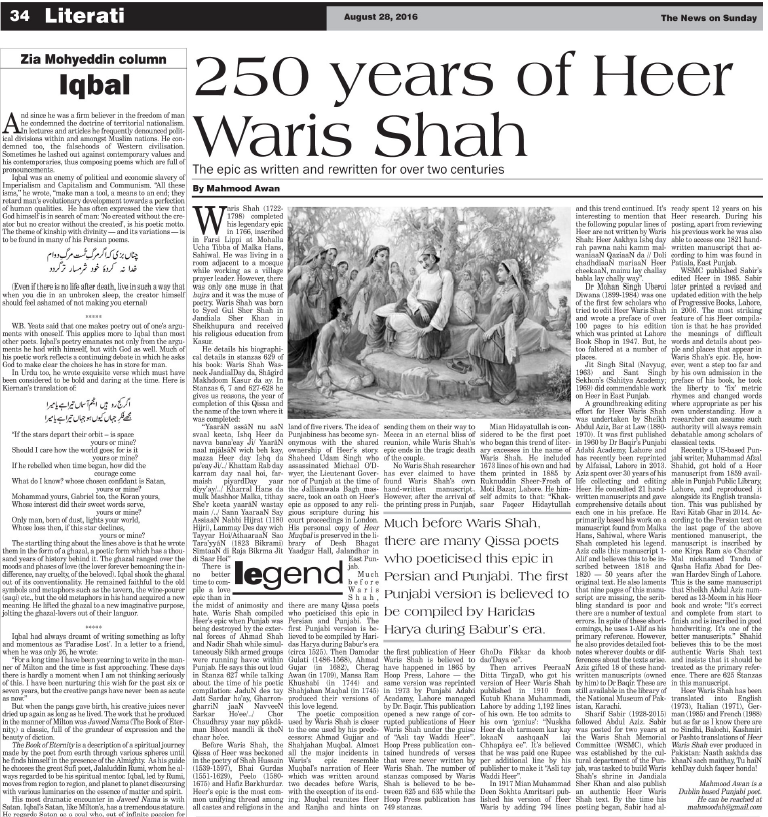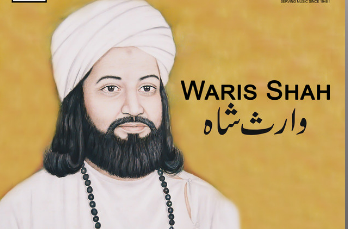Waris Shah (1722-1798) completed his legendary epic in 1766, inscribed in Farsi Lippi at Mohalla Ucha Tibba of Malka Hans, Sahiwal. He was living in a room adjacent to a mosque while working as a village prayer leader. However, there was only one muse in that hujra and it was the muse of poetry. Waris Shah was born to Syed Gul Sher Shah in Jandiala Sher Khan in Sheikhupura and received his religious education from Kasur.
He details his biographical details in stanzas 629 of his book: Waris Shah Wasneek JandialDay da, Shãgird Makhdoom Kasur da ay. In Stanzas 6, 7 and 627-628 he gives us reasons, the year of completion of this Qissa and the name of the town where it was completed:
“YaarãN assãN nu aaN svaal keeta, Ishq Heer da navva bana’eay Ji/ YaarãN naal mjãlsãN wich beh kay, mazza Heer day Ishq da pa’eay Ji/../ Khattam Rab day karram day naal hoi, farmaish piyardDay yaar diyy’ay/../ Kharral Hans da mulk Mashhor Malka, tithay She’r keeta yaarãN wastay main /../ Sann YaaraaN Say AssiaaN Nabbi Hijrat (1180 Hijri), Lammay Des day wich Tayyar Hoi/AthaaraaN Sao Tara’yyãN (1823 Bikrami) SimtaaN di Raja Bikrma Jit di Saar Hoi”
There is no better time to compile a love epic than in the midst of animosity and hate. Waris Shah compiled Heer’s epic when Punjab was being destroyed by the external forces of Ahmad Shah and Nadir Shah while simultaneously Sikh armed groups were running havoc within Punjab. He says this out loud in Stanza 627 while talking about the time of his poetic compilation: JaduN des tay Jatt Sardar ho’ay, Gharron-gharriN jaaN NavveeN Sarkar Ho’ee/../ Chor Chaudhray yaar nay pãkdãman Bhoot mandli ik thoN chaar ho’ee.
Before Waris Shah, the Qissa of Heer was beckoned in the poetry of Shah Hussain (1539-1597), Bhai Gurdas (1551-1629), Peelo (1580-1675) and Hafiz Barkhurdar. Heer’s epic is the most common unifying thread among all castes and religions in the land of five rivers. The idea of Punjabiness has become synonymous with the shared ownership of Heer’s story. Shaheed Udam Singh who assassinated Michael O’Dwyer, the Lieutenant Governor of Punjab at the time of the Jallianwala Bagh massacre, took an oath on Heer’s epic as opposed to any religious scripture during his court proceedings in London. His personal copy of Heer Muqbal is preserved in the library of Desh Bhagat Yaadgar Hall, Jalandhar in East Punjab.
Much before Waris Shah, there are many Qissa poets who poeticised this epic in Persian and Punjabi. The first Punjabi version is believed to be compiled by Haridas Harya during Babur’s era (circa 1525). Then Damodar Gulati (1486-1568), Ahmad Gujar (in 1682), Cherag Awan (in 1709), Mansa Ram Khushabi (in 1744) and Shahjahan Maqbal (in 1745) produced their versions of this love legend.
The poetic composition used by Waris Shah is closer to the one used by his predecessors: Ahmad Gujjar and Shahjahan Muqbal. Almost all the major incidents in Waris’s epic resemble Muqbal’s narration of Heer which was written around two decades before Waris, with the exception of its ending. Muqbal reunites Heer and Ranjha and hints on sending them on their way to Mecca in an eternal bliss of reunion, while Waris Shah’s epic ends in the tragic death of the couple.
No Waris Shah researcher has ever claimed to have found Waris Shah’s own hand-written manuscript. However, after the arrival of the printing press in Punjab, the first publication of Heer Waris Shah is believed to have happened in 1865 by Hoop Press, Lahore — the same version was reprinted in 1973 by Punjabi Adabi Acadamy, Lahore managed by Dr. Baqir. This publication opened a new range of corrupted publications of Heer Waris Shah under the guise of “Asli tay Waddi Heer”. Hoop Press publication contained hundreds of verses that were never written by Waris Shah. The number of stanzas composed by Waris Shah is believed to be between 625 and 635 while the Hoop Press publication has 749 stanzas.
Mian Hidayatullah is considered to be the first poet who began this trend of literary excesses in the name of Waris Shah. He included 1673 lines of his own and had them printed in 1885 by Ruknuddin Sheer-Frosh of Moti Bazar, Lahore. He himself admits to that: “Khaksaar Faqeer Hidaytullah GhoDa Fikkar da khoob dao’Daya ee”.
Then arrives PeeraaN Ditta TirgaD, who got his version of Heer Waris Shah published in 1910 from Kutub Khana Muhammadi, Lahore by adding 1,192 lines of his own. He too admits to his own ‘genius’: “Nuskha Heer da eh tarmeem kar kay lokaaN aashqaaN lai Chhapãya ee”. It’s believed that he was paid one Rupee per additional line by his publisher to make it “Asli tay Waddi Heer”.
In 1917 Mian Muhammad Deen Sokhta Amritsari published his version of Heer Waris by adding 794 lines and this trend continued. It’s interesting to mention that the following popular lines of Heer are not written by Waris Shah: Heer Aakhya Ishq day rah pawna nahi kamm malwaniaaN QaziaaN da // Doli chadhdiaaN mariaaN Heer cheekaaN, mainu lay challay babla lay chally way”.
Dr Mohan Singh Uberoi Diwana (1899-1984) was one of the first few scholars who tried to edit Heer Waris Shah and wrote a preface of over 100 pages to his edition which was printed at Lahore Book Shop in 1947. But, he too faltered at a number of places.
Jit Singh Sital (Navyug, 1963) and Sant Singh Sekhon’s (Sahitya Academy; 1969) did commendable work on Heer in East Punjab.
A groundbreaking editing effort for Heer Waris Shah was undertaken by Sheikh Abdul Aziz, Bar at Law (1880-1970). It was first published in 1960 by Dr Baqir’s Punjabi Adabi Academy, Lahore and has recently been reprinted by Alfaisal, Lahore in 2013. Aziz spent over 30 years of his life collecting and editing Heer. He consulted 21 hand-written manuscripts and gave comprehensive details about each one in his preface. He primarily based his work on a manuscript found from Malka Hans, Sahiwal, where Waris Shah completed his legend. Aziz calls this manuscript 1-Alif and believes this to be inscribed between 1818 and 1820 — 50 years after the original text. He also laments that nine pages of this manuscript are missing, the scribbling standard is poor and there are a number of textual errors. In spite of these shortcomings, he uses 1-Alif as his primary reference. However, he also provides detailed footnotes wherever doubts or differences about the texts arise. Aziz gifted 18 of these hand-written manuscripts (owned by him) to Dr Baqir. These are still available in the library of the National Museum of Pakistan, Karachi.
Sharif Sabir (1928-2015) followed Abdul Aziz. Sabir was posted for two years at the Waris Shah Memorial Committee (WSMC), which was established by the cultural department of the Punjab, was tasked to build Waris Shah’s shrine in Jandiala Sher Khan and also publish an authentic Heer Waris Shah text. By the time his posting began, Sabir had already spent 12 years on his Heer research. During his posting, apart from reviewing his previous work he was also able to access one 1821 hand-written manuscript that according to him was found in Patiala, East Punjab.
WSMC published Sabir’s edited Heer in 1985. Sabir later printed a revised and updated edition with the help of Progressive Books, Lahore, in 2006. The most striking feature of his Heer compilation is that he has provided the meanings of difficult words and details about people and places that appear in Waris Shah’s epic. He, however, went a step too far and by his own admission in the preface of his book, he took the liberty to ‘fix’ metric rhymes and changed words where appropriate as per his own understanding. How a researcher can assume such authority will always remain debatable among scholars of classical texts.
Recently a US-based Punjabi writer, Muhammad Afzal Shahid, got hold of a Heer manuscript from 1859 available in Punjab Public Library, Lahore, and reproduced it alongside its English translation. This was published by Ravi Kitab Ghar in 2014. According to the Persian text on the last page of the above mentioned manuscript, the manuscript is inscribed by one Kirpa Ram s/o Chandar Mal nicknamed Tandu of Qasba Hafiz Abad for Deewan Hardev Singh of Lahore. This is the same manuscript that Sheikh Abdul Aziz numbered as 13-Meem in his Heer book and wrote: “It’s correct and complete from start to finish and is inscribed in good handwriting. It’s one of the better manuscripts.” Shahid believes this to be the most authentic Waris Shah text and insists that it should be treated as the primary reference. There are 625 Stanzas in this manuscript.
Heer Waris Shah has been translated into English (1973), Italian (1971), German (1985) and French (1988) but as far as I know there are no Sindhi, Balochi, Kashmiri or Pashto translations of Heer Waris Shah ever produced in Pakistan: Naath aakhda das khaaN sach maithay, Tu haiN kehDay dukh faqeer honda!
Published on 28th August 2016 in The News on Sunday.
https://www.thenews.com.pk/tns/detail/561611-250-years-heer-waris-shah


